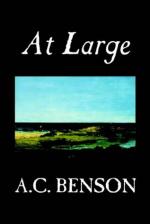Things of which the ultimate end is to affect human
beings must take human beings into account. If
you aim at appealing only to other craftsmen, it becomes
an erudite business: you become like a carpenter
who makes things which are of no use except to win
the admiration of other carpenters. Of course
it may be worth doing if you are content with indicating
a treatment which other people can apply and popularise.
But if you isolate art into a theory which has no
application to life, you are a savant and not an artist.
You can’t be an artist without being a man, and
therefore I hold that humanity comes first. I
don’t mean that one need be vulgar. Of
course I am a mere professional, and my primary aim
is to earn an honest livelihood. I frankly confess
that I don’t pose, even to myself, as a public
benefactor. But Herries does not care either
about an income, or about touching other people.
Of course I should like to raise the standard.
I should like to see ordinary people capable of perceiving
what is good art, and not so wholly at the mercy of
conventional and melodramatic art. But Herries
does not care twopence about that. He is like
the Calvinist who is sure of his own salvation, has
his doubts about the minister, and thinks every one
else irreparably damned. As I say, it is a lofty
sort of ideal, but it is not a good sign when that
sort of thing begins. The best art of the world—let
us say Homer, Virgil, Dante, Shakespeare—was
contributed by people who probably did not think about
it as art at all. Fancy Homer going in for questions
of form! It is always, I believe, a sign of decadence
when formalism begins. It is just like religion,
which starts with a teacher who has an overwhelming
sense of the beauty of holiness; and then that degenerates
into theology. These young men are to art what
the theologians are to religion. They lose sight
of the object of the whole thing in codification and
definition. My own idea of a great artist is
a man who finds beauty so hopelessly attractive and
desirable that he can’t restrain his speech.
It all has to come out; he cannot hold his peace.
And then a number of people begin to see that it was
what they had been vaguely admiring and desiring all
the time; and then a few highly intellectual people
think that they can analyse it, and produce the same
effects by applying their analysis. It can’t
be done so; art must have a life of its own.”
“Yes,” I said, “I think you are right. Herries is ascetic and eremitical—a beautiful thing in many ways; but there is no transmission of life in such art; it is a sterile thing after all, a seedless flower.”
“Let us express the vulgar hope,” said Musgrave, “that he may fall in love; that will bring him to his moorings! And now,” he added, “we will go to the music-room and I will see if I cannot tempt the shy bird from his roost.” And so we did—Musgrave is an excellent musician. We flung the windows open; he embarked upon a great Bach “Toccata”; and before many bars were over, our idealist crept softly into the room, with an air of apologetic forgiveness.




